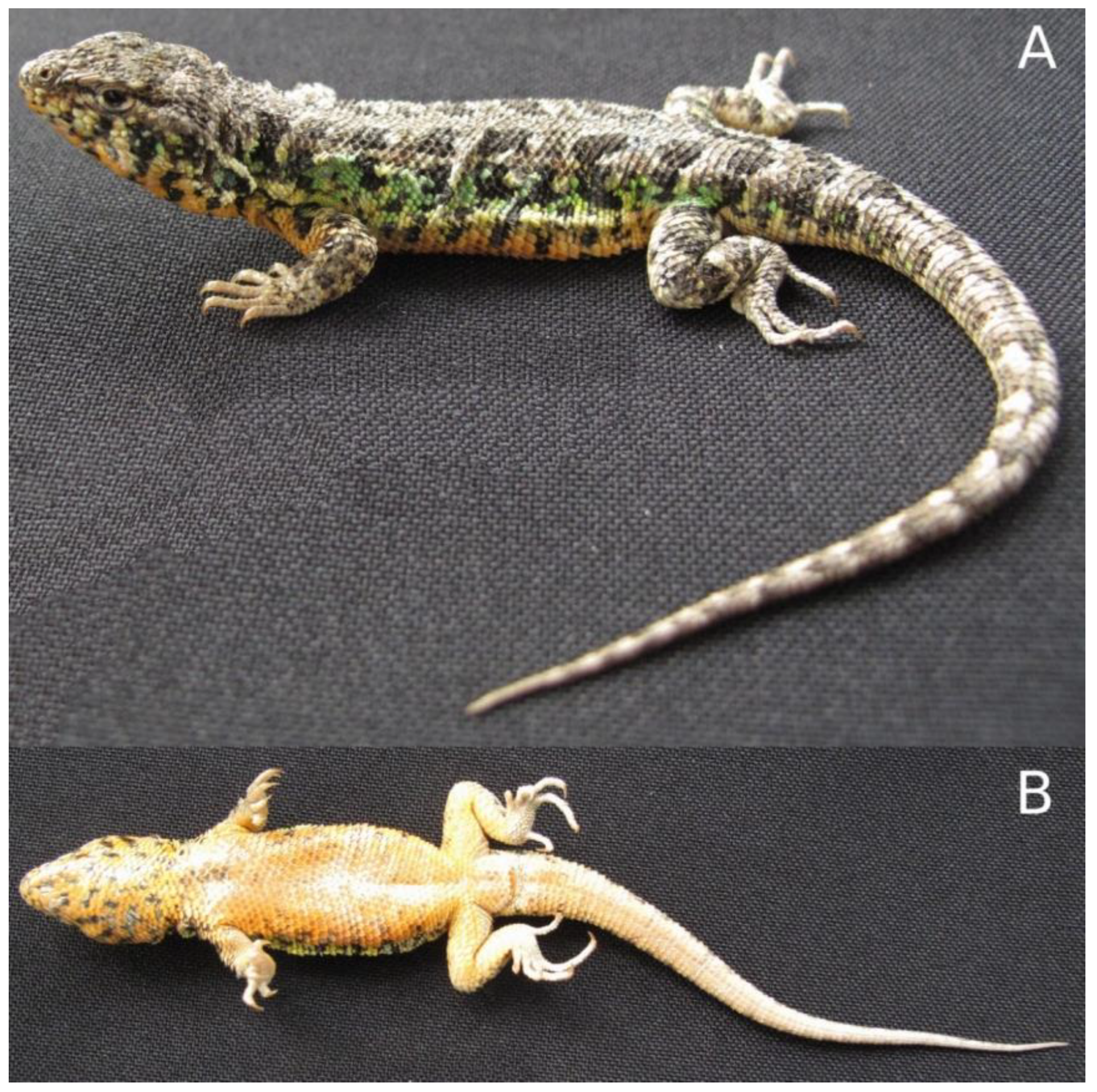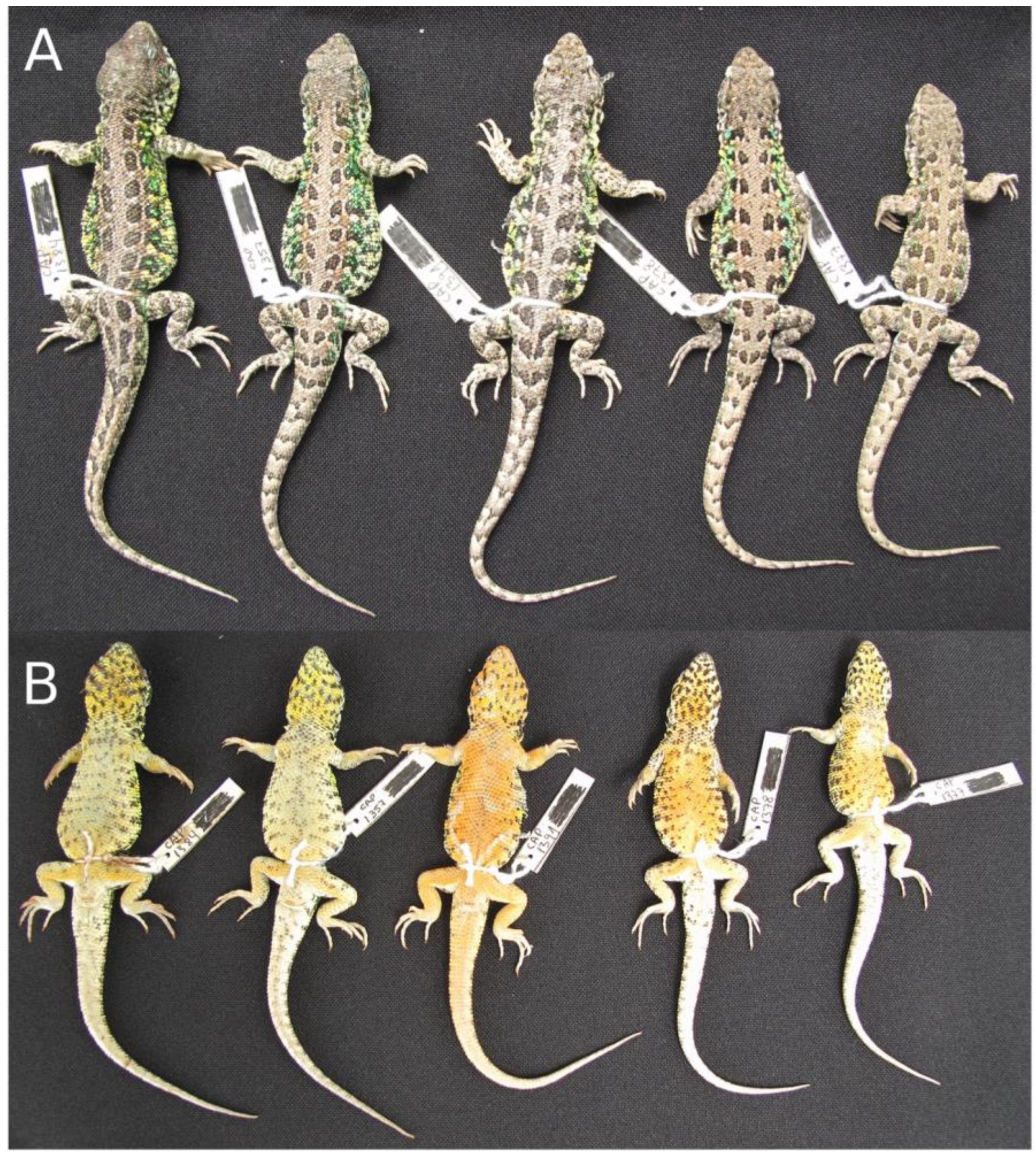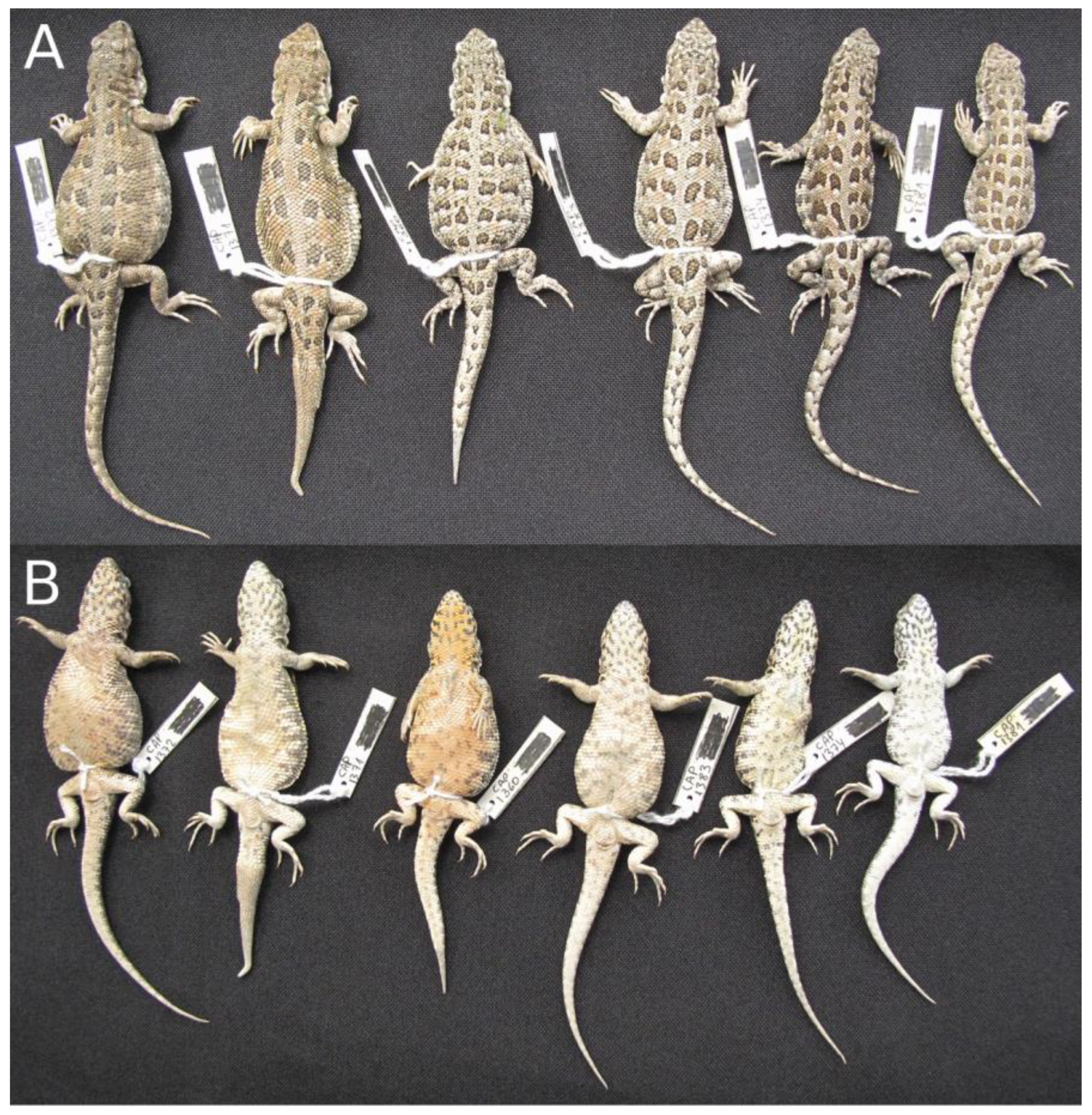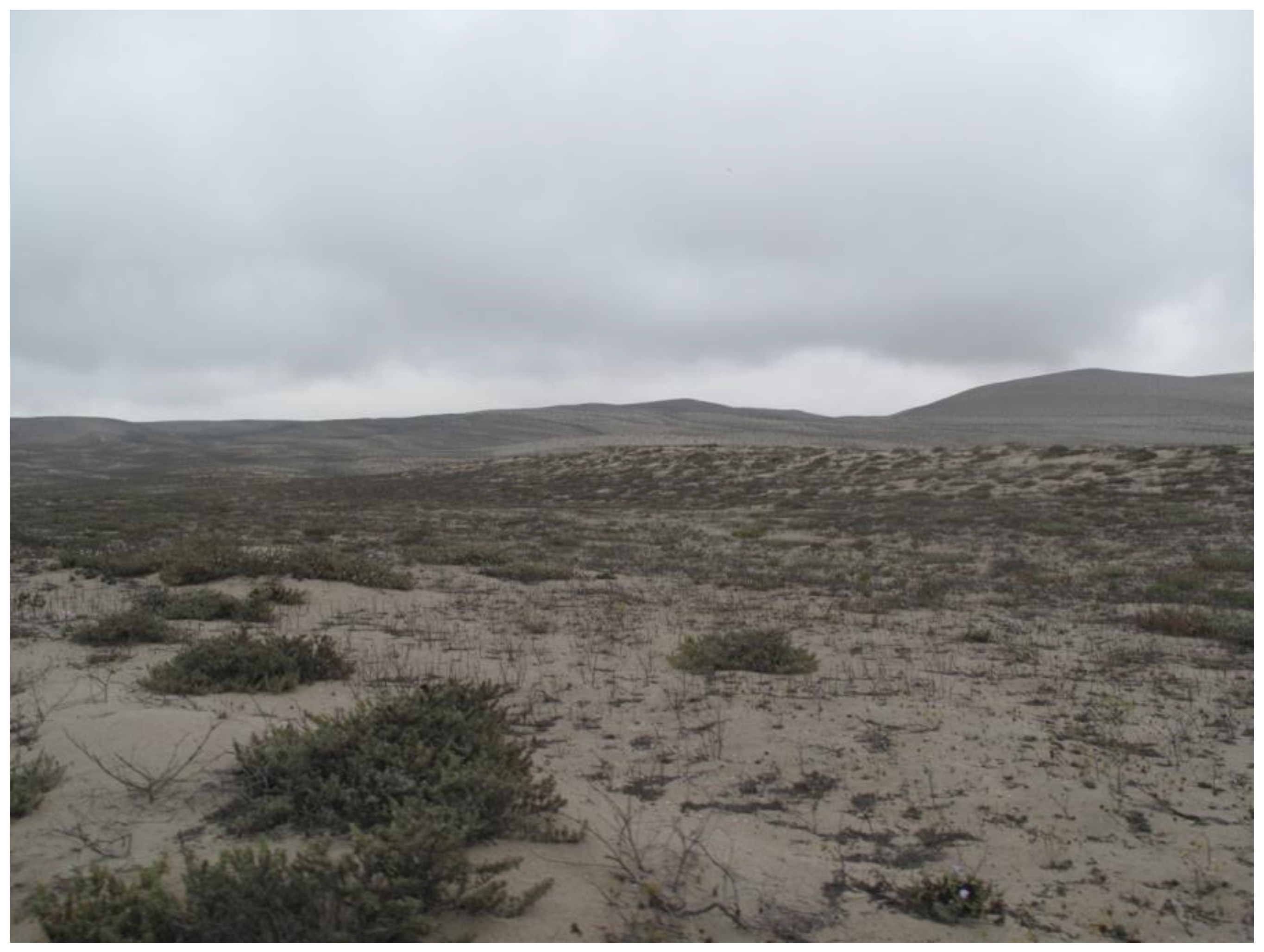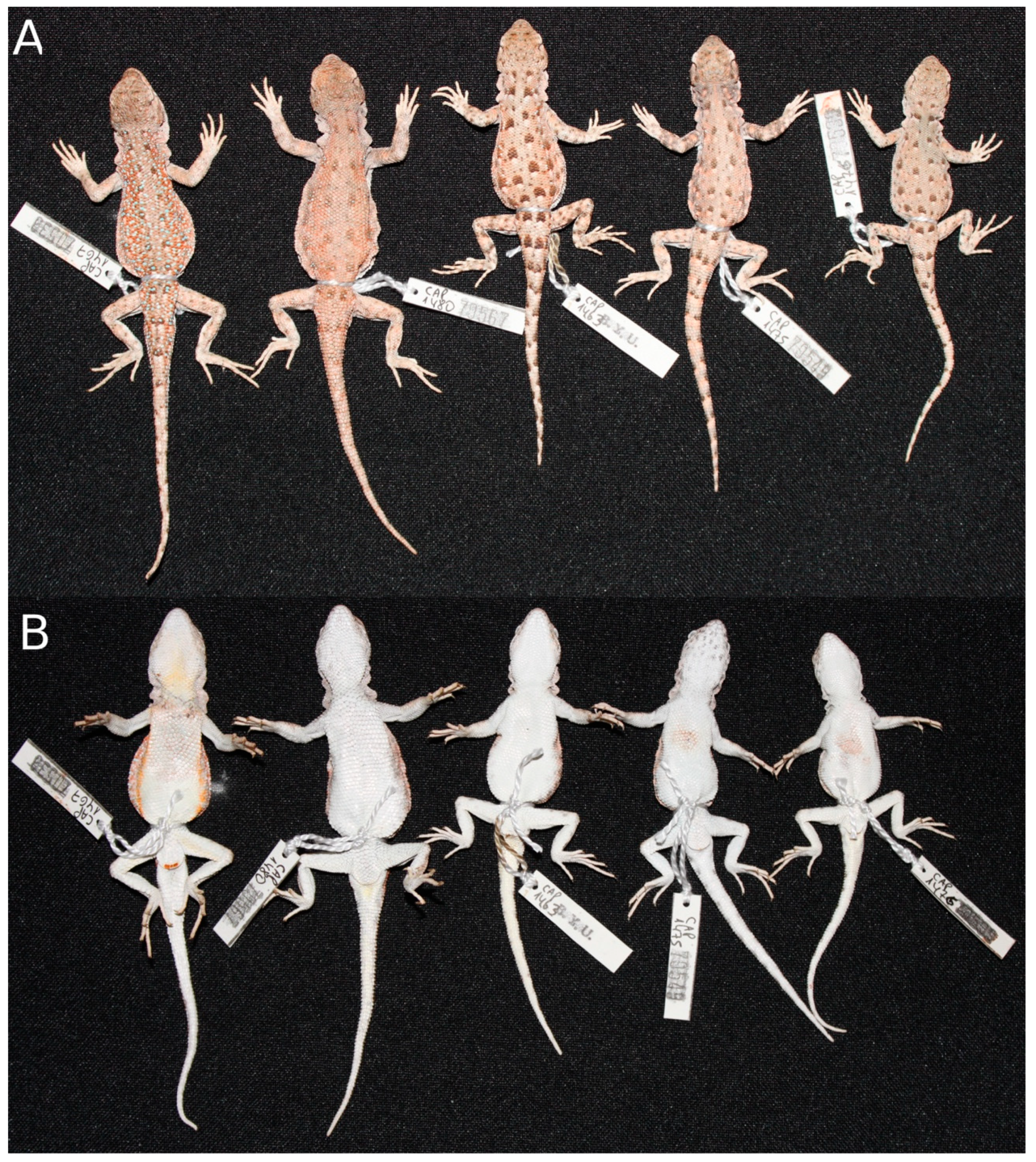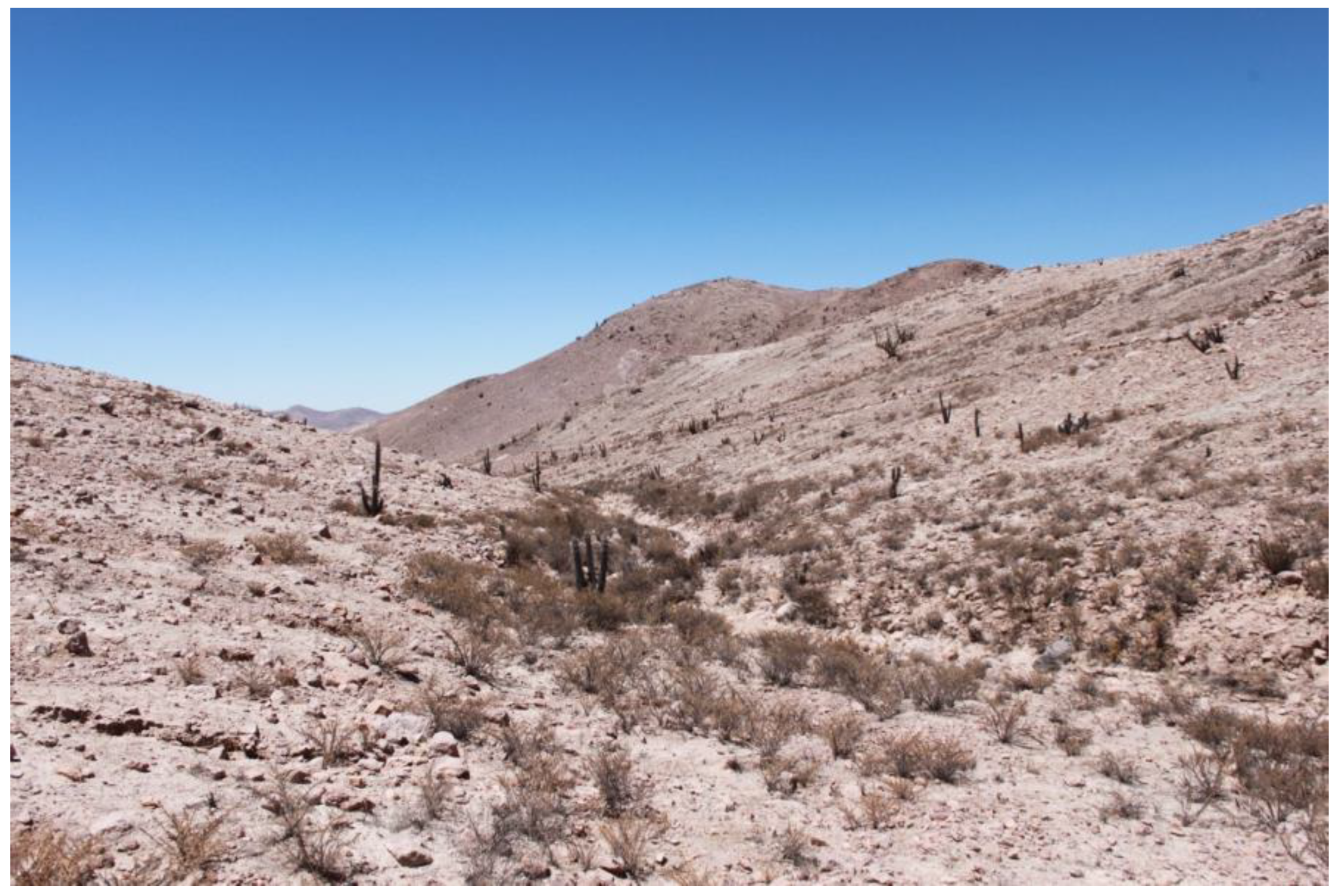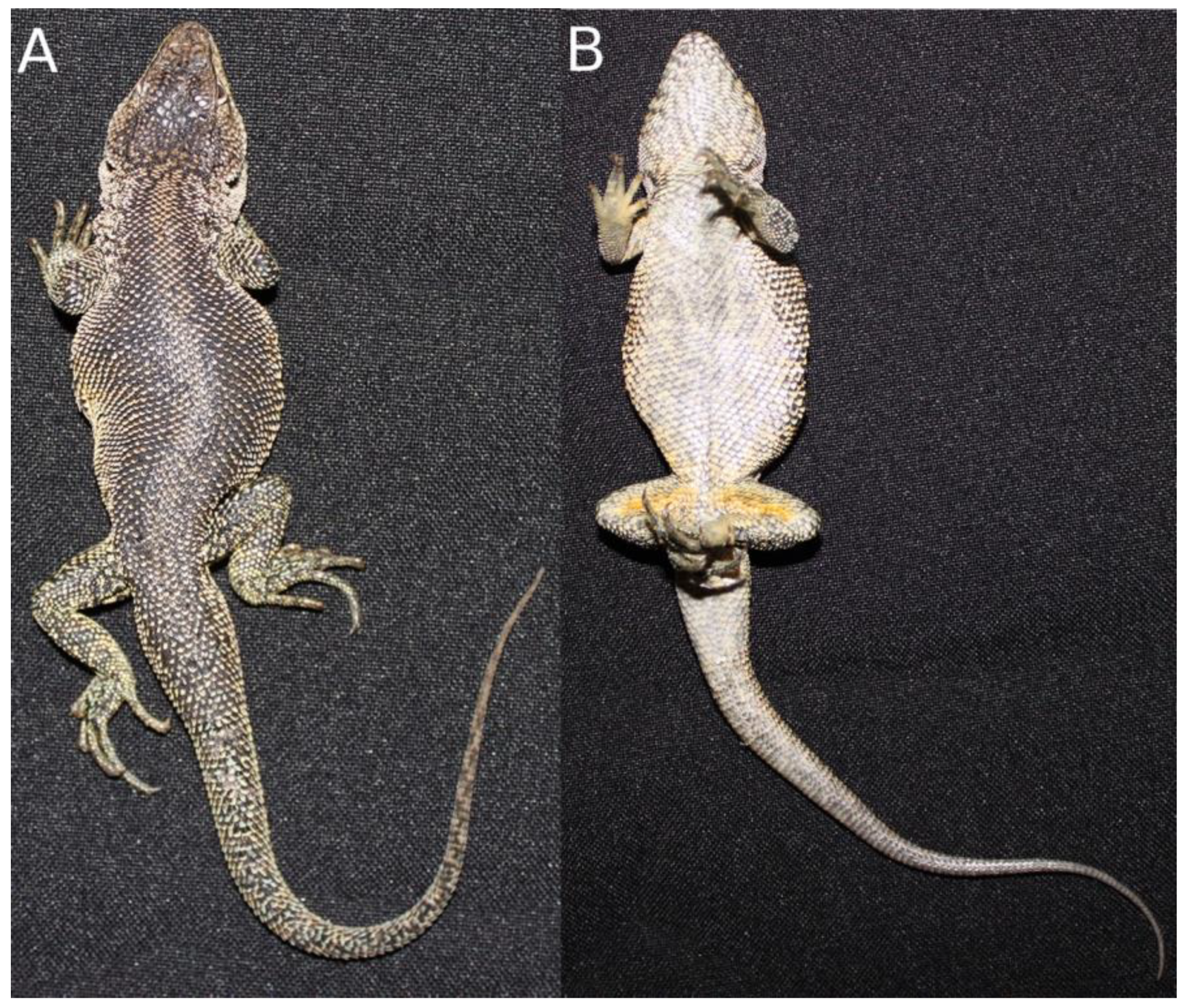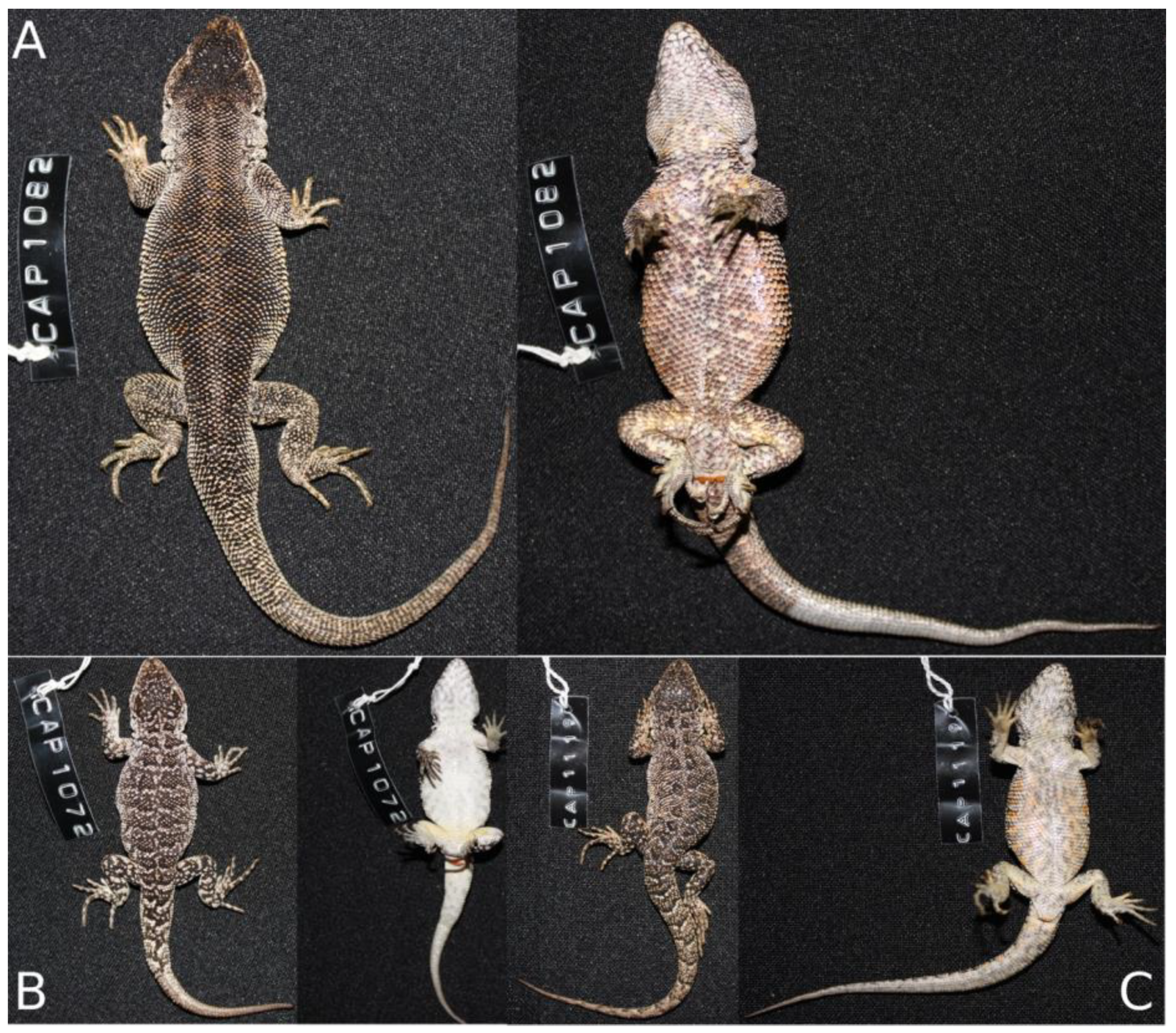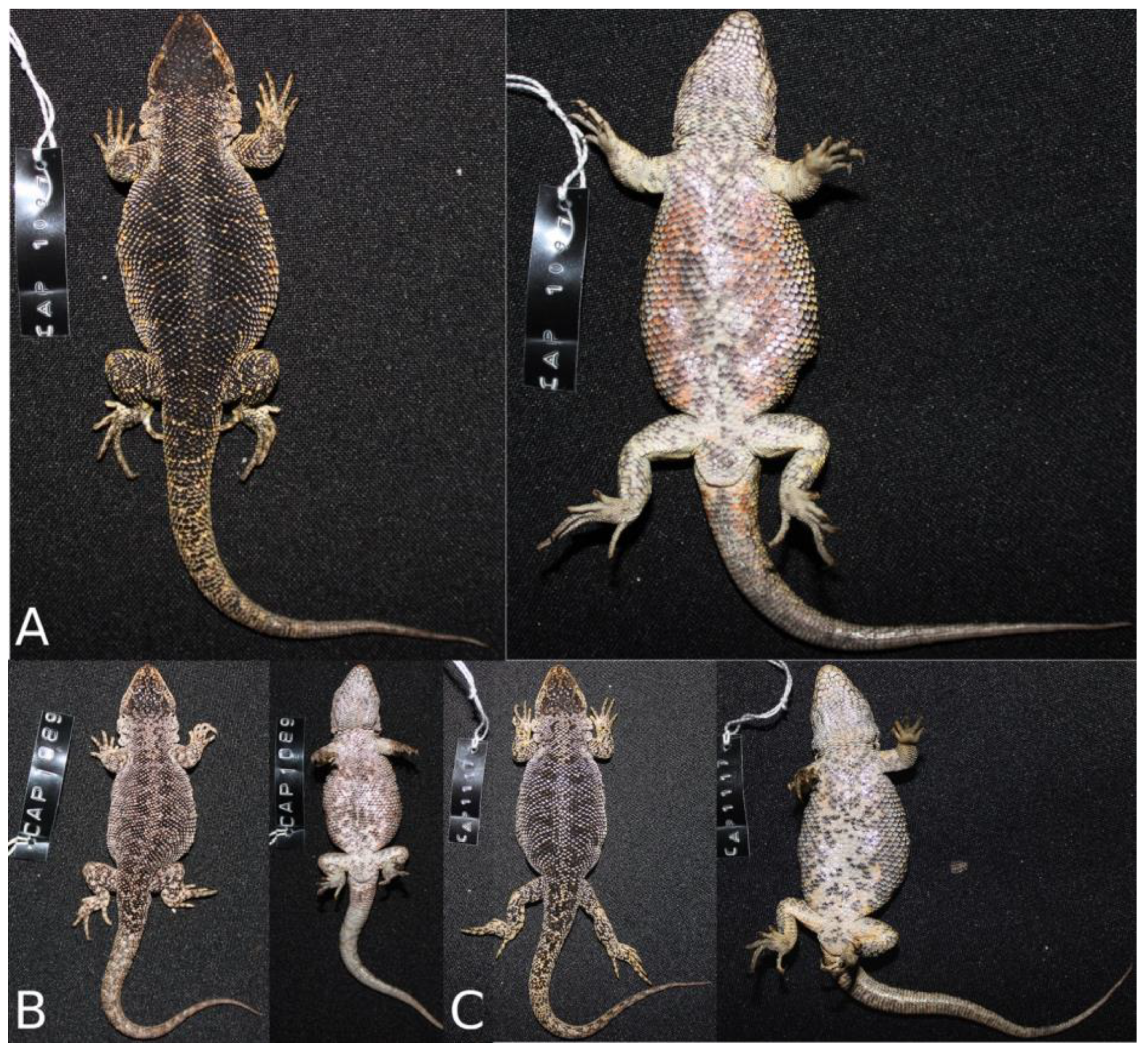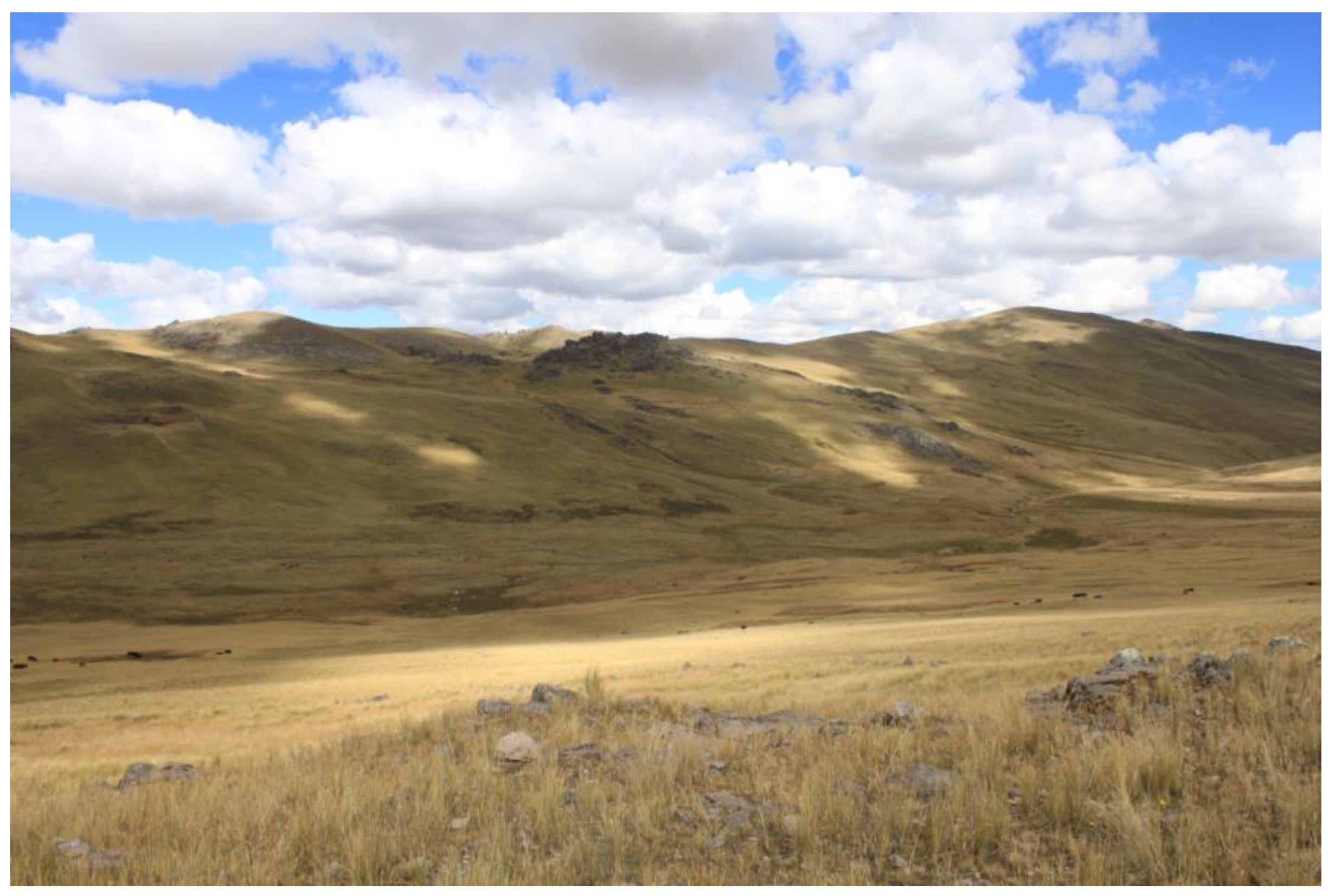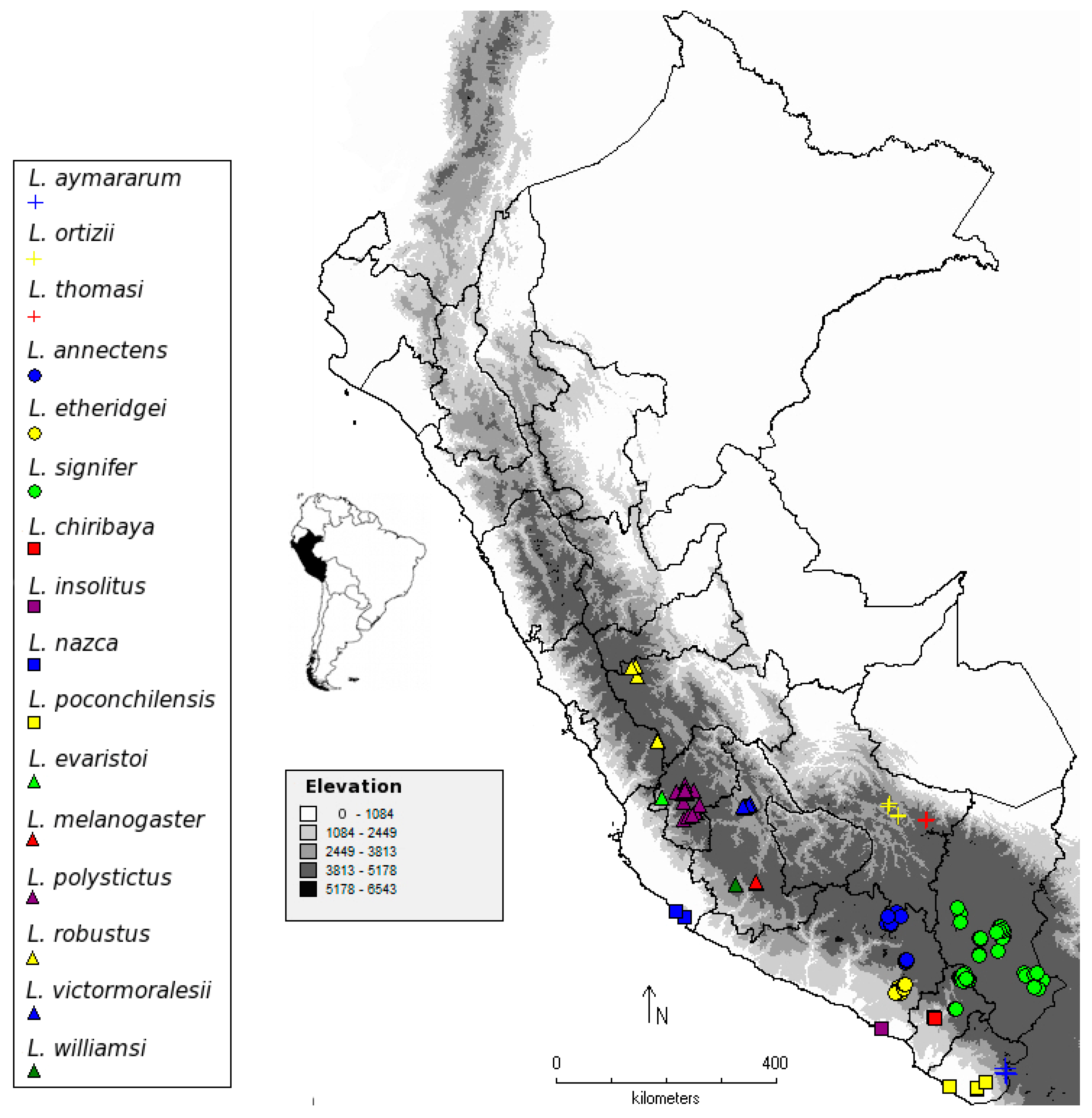3. Results
Below we describe three new species previously recognized as candidate species [
2,
3]. However, as candidate species without a formal description they probably will not get legal protection. Legal protection is afforded for taxa with scientific names in a formal species description. Once candidate species have names, they will be available and can be incorporated into local protected and international conservation lists. For this reason, we describe three new species of
Liolaemus lizards and we hope in the near future they will be evaluated and be part of a conservation program if needed.
Species Description
Liolaemus nazca
2017. Liolaemus “Nazca” Aguilar et al.
Holotype. MUSM 31523: adult male collected in Marcona District, Nazca Province, Department of Ica, Peru, 15.120 S, 75.338 W, 466 m, on 17 January 2013 by César Aguilar, César Ramírez and Alejandro Mendoza.
Paratypes. MUSM 16100, 31520, 31526, 31541: four adult males, same data as holotype. MUSM 31,521, 31,525, 16,101: three adult females, same data as holotype. MUSM 31524, 31527, 31522: three juveniles, same data as holotype.
Referred specimens. BYU 50471–50472: two males, same data as holotype. BYU 50506–50508, BYU 50510: four females, same data as holotype.
Diagnosis. Liolaemus nazca belongs to the L. montanus group because it lacks a patch of enlarged scales on the posterior thighs. Liolaemus nazca forms a clade with other Pacific coast species, L. insolitus, L. poconchilensis and L. chiribaya sp. nov. It differs from L. poconchilensis in being larger (with a maximum SVL of 59.8 mm; 55.9 mm in L. poconchilensis) and lacking enlarged serrate ciliary scales. L. nazca differs from L. insolitus and L. chiribaya sp. nov. by having slightly keeled dorsal scales on the body, which become more conspicuous towards the vertebral line. Liolaemus nazca also differs from L. poconchilensis and L. chiribaya sp. nov. by lacking a “phrynosauroid” or “toad-like” head. Liolaemus nazca presents an intense orange or yellow ventral region with dark spots, in contrast to L. insolitus and L. poconchilensis, both of which have clearer ventral regions, and L. chiribaya sp. nov. which has two orange lateral stripes on venter.
Liolaemus nazca is distinguished from other Peruvian species of the L. montanus group by its bright green and turquoise scales on body flanks surrounded by yellow and black scales. Liolaemus nazca also differs from L. aymararum, L. evaristoi, L. melanogaster, L. polystictus, L. robustus, L. thomasi and L. williamsi in having a smaller SVL (65.9 mm versus 70.1–103.0 mm). Liolaemus nazca has fewer scales around midbody (53–62) than L. signifer (67–110), and the number of vertebral scales (between the occiput and anterior level of hind limbs) in L. nazca is smaller (53–57 scales) than L. evaristoi and L. signifer (60–129 scales), and greater than those of L. aymararum, L. ortizii and L. thomasi (30–53). Liolaemus nazca differs from L. etheridgei, L. ortizii and L. thomasi, all of which have noticeably keeled scales. Liolaemus nazca females differs from L. melanogaster, L. polystictus and L. thomasi females by having vestigial precloacal pores. Liolaemus nazca males have fewer precloacal pores (3–6) than males of L. annectens (6–7) and L. etheridgei (6–9).
Description of the holotype. Adult male, SVL 64.5 mm, head length 16.3 mm, head width 13.2 mm, head height 9.5 mm, groin armpit distance 26.4 mm (39.8% SVL), foot length 16.3 mm (25.3% SVL), tail length 77.6 mm (120.3% SVL). 20 dorsal head scales (between the anterior edge of the auditory meatus to the anterior edge of the rostral); dorsal head scales smooth, occipitoparietal scales irregular and convex, frontonasal and parietal area with convex scales; scale organs more abundant in the prefrontal, internasal, lorilabial and loreal regions; supralabial region without scales organs; three organs in the left and one in the right post-rostral. Nasal scale separated from rostral, and separated from the first supralabial by one scale, right nasal bordered by eight scales; cantal separated from nasal by two scales. Six supralabials. Ten lorilabial scales, four in contact with subocular. Six infralabials. Oval auditory meatus (height 2.4 mm, width 1.0 mm) with two small scales on anterior margin. Seven smooth and convex temporal scales. Distance between orbit and auditory meatus 6.5 mm. Rostral almost three times as wide as tall (width 2.8 mm; height 1.1 mm). Mental subpentagonal, almost twice as wide as tall (width 2.7 mm; height 1.5 mm). Hourglass-shaped interparietal, with elongated posterior apex, bordered by eight scales, parietals of similar size as interparietal. Frontal quadrangular. Complete supraorbital semicircles on both sides. Semicircles formed by 13 scales. Four enlarged supraoculars. Six superciliares overlapping on both sides. Ten upper and nine lower ciliary scales. Subocular elongated, larger than eye diameter, separated from supralabials by a single row of lorilabials. Supralabials of similar size. Eight lorilabials, with double and triple rows of scale organs. Eighth, seventh, sixth and fifth lorilabials in contact with subocular. Preocular separated from the lorilabial row by two scales. Postocular as large as preocular. Mental in contact with five scales, three infralabials (on each side) and two enlarged chin scales. Chin scales forming a longitudinal row of four enlarged scales separated one from the other by seven small scales. Gular scales rounded, flat and imbricated. 24 gulars between auditory meatus. Longitudinal neck fold without keeled scales, almost half in size of dorsal scales. Antehumeral pocket and folds well developed. 36 scales between auditory meatus and shoulder (counting along the post-auricular and longitudinal neck fold), 21 scales between the auditory meatus and the neck fold. Gular fold absent. Dorsal scales imbricated, slightly keeled, more conspicuous towards vertebral line. 53 dorsal scales between the occiput and groin level. 54 scales around midbody. Dorsal scales smooth towards flanks and belly. Ventral scales slightly wider than dorsal. 65 ventral scales between mental scale and cloaca; four precloacal pores. Supracarpals smooth and laminar with oval margins. Subdigital lamellae of fingers with three keels, formula I:8; II:12; III:17; IV:17; V:10 (right hand). Supradigital lamellae smooth and imbricated. Infracarpals and infratarsals keeled and imbricated. Supratarsals smooth and angular, but slightly keeled on fourth finger. Subdigital lamellae toe formula I:8; II:13; III:17; IV:21; V:13 (right foot).
Color pattern in life. (
Figure 1) Dorsal color light brown with two paravertebral series of eight dark brown spots, more or less symmetrical, between occiput and pelvis, dark brown spots bordered by lighter scales. Lateral region of the body from cheek (postocular region) to the post-cloacal zone (tail base) with patches of emerald green scales on a bright yellow background, interrupted by dark brown transverse spots. Dorsal head brown with dark black spots. Area surrounding loreal, subocular, mental and ocular scales with bright yellow background color; five dark stripes on lateral head, one projects from eye to postocular and temporal region, one to mouth corner, two through subocular and labial region, and one through preocular and nasal. Dorsal limbs light brown with dark spots not reaching phalanges. Tail with dark brown subtriangular spots, which merge towards tip of tail. Ventral head, body and tail bright orange, with dark spots on head, and some on neck and belly.
Color pattern in preservative. Dorsal background from neck to tip of tail is brown. On dorsal head, dark spots become more evident. Ventral region presents a whitish background coloration; dark spots accentuate and become more conspicuous.
Variation. (
Figure 2 and
Figure 3). Variation in selected characters is summarized in
Table 1. Sexual dichromatism present. Males have two paravertebral series of 6–8 dark brown spots on dorsum surrounded or not by white scales; body flanks with emerald green spots surrounded by yellow and dark brown spots; emerald green spots are present from lower temporal region of head to first third of tail; in young specimens emerald green spots are smaller and do not reach first third of tail. Males with orange or yellow on ventral surface of body, and limbs, with small dark spots in gular region, sometimes forming reticulations. Adult females have throat, belly and base of tail orange, yellowish or whitish, with or without dark spots or reticulations on belly.
Distribution and natural history (
Figure 4).
Liolaemus nazca is only known in Nazca province, Ica department, at elevations of 450–700 m. It was found on the ground or in shallow holes on the ground, mainly in hills (“Lomas”) with low shrub vegetation and sandy soil, less frequently in areas with
Tillandsia sp. In the summer, some individuals were active as early as 7:27 and as late as 16:22; on winter no individuals were observed. Body temperature of ten specimens ranged 22.7–34.0 °C (substrate temperature: 22.8–44.1 °C; air temperature: 21.4–31.0 °C). It was found together with
Ctenoblepharys adspersa, Microlophus sp. and
Phyllodactylus gerrophygus. This species is viviparous, one female had two embryos on each side at an advanced stage of development. On the Pacific coast,
L. nazca is the northernmost species of
Liolaemus.
Etymology
The specific epithet nazca is a noun in apposition and is given in honor to the Nazca culture (100–800 A.D.). Among the famous Nazca lines, there is a lizard geoglyph.
Liolaemus chiribaya
2018. Liolaemus “Moquegua” Aguilar-Puntriano et al.
Holotype. MUSM 31547: adult male collected near “Cerros Los Calatos”, 16.91892S, 70.89596W, Torata District, Mariscal Nieto Province, Moquegua Department, Perú, 2615 m, December 19, 2014 by César Aguilar, Jessie Montalvo and Maribel Angeles.
Paratypes. MUSM 31553: adult male collected in Jaguay Chico, Torata District, Mariscal Nieto Province, Moquegua Department, Peru 16.94567 S, 70.88486 W, 2928 m, December 19, 2014; MUSM 31549–31550: one female and juvenile collected in the same location and date as previous specimen, 2942 and 2913 m respectively; MUSM 31548: a female collected near the Asirune Archaeological Zone, near Jaguay Chico, Torata District, Mariscal Nieto Province, Moquegua Department, Peru, 16.95213 S, 70.87854 W, 2990 m; all above paratypes collected by César Aguilar, Jessie Montalvo and Maribel Angeles; MUSM 31386–31388, 31390–31391: five males and MUSM 31389: one female collected in “Cerro Los Calatos”, Torata District, Mariscal Nieto Province, Moquegua Department, Perú, 2794–2988 m, 27–29 December 2012 by Juana Suárez.
Referred specimens. BYU 51568, BYU 51570: two males, collected in Jaguay Chico, Torata District, Mariscal Nieto Province, Moquegua Department, Perú; MUSM 31546: male collected near the Asirune Archaeological Zone, near Jaguay Chico, Torata District, Mariscal Nieto Province, Moquegua Department, Perú; BYU 51564, BYU 51566–51567: two females and one juvenile with same data as MUSM 31546.
Diagnosis. Liolaemus chiribaya is identified as a member of the L. montanus group by the absence of a patch of enlarged scales on posterior thighs. Liolaemus chiribaya forms a clade with L. insolitus, L. poconchilensis and L. nazca sp. nov. It differs from L. poconchilensis by having a fourth finger extending beyond the armpit when a hindlimb is brought forward (fourth finger does not exceed past the armpit in L. poconchilensis); male L. chiribaya further differs from L. poconchilensis by the presence of dorsal turquoise spots (absent in males of L. poconchilensis), and differs from L. nazca by having smooth dorsal body scales (dorsal body scales slightly keeled in L. nazca). In addition, L. chiribaya lacks an orange or yellow venter with dark spots. Liolaemus chiribaya differs from L. insolitus by having a greater number of scales around midbody (58–69 vs. 45–53). Liolaemus chiribaya differs from L. nazca, L. insolitus and other Peruvian species of the L. montanus group (except L. poconchilensis) by having a “phrynosauroid” head. Liolaemus chiribaya also differs from other Peruvian species of the L. montanus group by having dorsal turquoise scales and a maximum 68.8 mm SVL, being a smaller species than L. aymararum, L. evaristoi, L. melanogaster, L. polystictus, L. robustus, L. thomasi and L. williamsi (SVL 70.1–103.0 mm). L. chiribaya has fewer scales around midbody (54–66) than L. signifer (67–110), fewer maximum number of dorsal scales (between occiput and anterior level of hindlimb; 64) than L. evaristoi (75) and L. signifer (129), and more than L. aymararum, L. ortizii and L. thomasi (all ≤ 53). It also differs from L. etheridgei, L. ortizii and L. thomasi by lacking strongly keeled scales. Females of L. chiribaya also have vestigial precloacal pores, which are absent in females of L. melanogaster, L. polystictus and L. thomasi.
Description of the holotype. Adult male, SVL 52.6 mm, head length 14.2 mm, head width 11.7 mm, head height 7.6 mm, groin armpit distance 20.3 mm (38.6% SVL), foot length 14.3 mm (27.2 % SVL), tail length 54.2 mm (103% SVL). 21 dorsal scales on head; smooth dorsal head scales, occipital, parietal and frontonasal area with convex scales, parietal scales polygonal; scale organs numerous in prefrontal, lorilabial and loreal scales; supralabial scales with few scales organs; five organs in the left postrostral and four in the right. Nasal scale separated from rostral, separated by a scale from first supralabial, right nasal limited by eight scales; canthal separated from nasal by two scales. Seven supralabials. Eight lorilabial scales, three in contact with the subocular. Seven infralabials. Oval auditory meatus (height 1.8 mm; width 1.2 mm), with two small protruding scales on anterior margin. Eight smooth and convex temporal scales. Distance between orbit and auditory meatus 4.1 mm. Rostral three times wider than high (width 2.4 mm; height 0.8 mm). Mental subpentagonal, almost twice as wide as high (width 2.4 mm; height 1.3 mm). Interparietal pentagonal, with elongated posterior apex, bordered by five scales, parietals larger than interparietal. Frontal scales polygonal. Complete supraorbital semicircles on both sides. Semicircles formed by 13 scales. Three enlarged supraoculars. Eight superciliares. 14 upper and 12 lower ciliaries. Subocular divided into three, longer than eye diameter, posterior subocular larger and separated from supralabials by a single row of lorilabials. Supralabials of similar size. Lorilabial eighth and seventh in contact with subocular. Preocular of medium size, separated from lorilabial row by a scale. Postoculars of similar size to preocular. Mental scale in contact with four scales: two infralabials (on each side) and two enlarged chin scales. Chin scales forming a longitudinal row of four enlarged scales separated from each other by 12 scales. Gular scales rounded, flat and overlapped with very few scale organs. 25 gular scales between auditory meatus. Longitudinal neck fold without keeled scales, almost half in size of dorsal scales. Antehumeral pocket and well developed antehumeral neck folds. 30 scales between auditory meatus and shoulder (counting along post-auricular and longitudinal neck fold), 25 scales between the auditory meatus and the neck fold. Gular fold absent. Dorsal scales juxtaposed or poorly imbricated. 60 dorsal scales between occiput and groin level. 64 scales around midbody. Dorsal scales smooth on flanks and belly. Ventral scales slightly wider than dorsal scales. 74 ventral scales between mental and cloaca; four precloacal pores present. Smooth laminar supracarpals, with oval or rounded margins. Subdigital lamellae of fingers with three keels, and with formula I:7; II:11; III:15; IV:17; V:8 (right hand). Smooth and imbricated supradigital lamellae. Smooth infratarsals and keeled infracarpals, both strongly imbricated. Supratarsal smooth, oval or rounded. Subdigital lamellae of toes with formula I:9; II:11; III:16; IV:18; V:13 (right foot).
Color pattern in life (
Figure 5). Dorsal paravertebral orange and turquoise scales from neck region to tail base. Dorsal head with pale orange and brown scales on occipital and frontal region. Dark brown scales on supraocular, parietal region and snout. Dorsal limbs pale orange, with some orange scales and dark brown scales forming zigzag spots up to base of digits (hand) or on digits (foot). First third of tail with turquoise and orange scales, with dark scales forming transverse bands or spots. Ventral scales on head, limbs and tail white smoke, belly with two orange lateral stripes separated by a central area of pale yellowish scales. Ventral tail white smoke.
Color pattern in preservative. Dorsal light gray scales on vertebral region and dark brown scales on paravertebral region, from neck to tail base. Dorsal head with light gray scales on occipital, parietal, frontal and prefrontal regions. Dark olive scales on supraocular, and some on parietal and temporal region, creamy scales on snout. Dorsal limbs pale gray, with gray scales forming zigzag marks up to base of digits (hand) or on digits (foot). Tail pale gray with dark scales forming transverse bands or spots. Ventral scales white smoke on head, limbs, tail and belly.
Variation. (
Figure 5 and
Figure 6). Variation in selected characters is summarized in
Table 2. Sexual dichromatism present. Females and juveniles on dorsal body have 6 to 8 triangular or quadrangular marks, sometimes bordered by lighter scales; without turquoise blue scales; males with or without triangular or quadrangular marks, but if present marks are usually covered by turquoise blue scales; venter whitish without orange lateral stripes.
Distribution and natural history (
Figure 7).
Liolaemus chiribaya is only known in the District of Torata, Province of Mariscal Nieto, Department of Moquegua, at elevations of 2615–3005 m; they were found under rocks or on ground in desert areas with cacti and low shrubs; they were active between 10:00 and 14:00. Other lizard species present in the area were
Phyllodactylus gerrophygus and
L. tacnae.
Etymology. The specific epithet chiribaya is a noun used in apposition and honors the Chiribaya culture (900–1350 A.D.). Chiribayans were settled in the basin of the Ilo River, and expanded north to the Tambo valley (Arequipa) and the south to the Azapa valley (Chile), including the high altitude regions, up to nearly 3000 m of elevation.
Liolaemus victormoralesii
2017. Liolaemus “Abra Toccto” Aguilar et al.
2018. Liolaemus “Abra Toccto” Aguilar-Puntriano et al.
Holotype. MUSM 31461: adult male collected at Abra Toccto, Huamanga Province, Ayacucho Department, Perú, 13.346 S, 74.184 W, elevation 4222 m, on 01 June 2012 by César Aguilar, Víctor J. Vargas, Frank Huari and Elver Coronado.
Paratypes. MUSM 31371–31372, 31460: three adult males collected at Abra Toccto, Huamanga Province, Ayacucho Department, Perú, 13.298 S, 74.091 W, elevation 4193–4215 m on 3 December 2012 by Alfredo Guzmán and Víctor J. Vargas; MUSM 31460, 31468: two adult females, same data as holotype; MUSM 31463: juvenile collected at Abra Toccto, Huamanga Province, Ayacucho Department, Perú, 13.35 S, 74.187 W, elevation 4182m, on 04 June 2012 by César Aguilar, Víctor J. Vargas, Frank Huari and Elver Coronado. MUSM 25700, adult male collected at Chiara, Huamanga Province, Ayacucho Department, Perú, 13.341 S, 74.216 W, elevation 4145m, on 30 November 2006 by Margarita Medina.
Referred specimens. BYU 50431, BYU 50427, MUSM 31462: three males, same data as holotype; BYU 50433, BYU 50428: two females, same data as holotype.
Diagnosis. Liolaemus victormoralesii is identified as a member of the L. montanus group by the absence of a patch of enlarged scales on posterior thighs. Liolaemus victormoralesii forms a clade with L. evaristoi, L. melanogaster, L. polystictus, L. robustus and L. williamsi. It differs from closely related L. evaristoi by lacking blue scales on the dorsum and flanks, having a larger size (maximum SVL 88.9 mm in L. victormoralesii and 70.1 mm in L. evaristoi) and by lacking vestigial precloacal pores in females. Liolaemus victormoralesii differs from L. melanogaster by lacking black belly scales (gray scales in adult L. victormoralesii). Adult females of L. victormoralesii differ from L. polystictus and L. williamsi females by having a darker dorsal background coloration and few large contrasting marks dorsally (L. polystictus and L. williamsi have a lighter dorsal background coloration and large number of small contrasting marks dorsally). Liolaemus victormoralesii further differs from L. williamsi by having a larger size (maximum SVL 74.9 mm in L. williamsi) and by lacking vestigial precloacal pores in females. Liolaemus victormoralesii differs from L. robustus by lacking dorsal yellow greenish scales. Adult males of Liolaemus victormoralesii differs from L. etheridgei by lacking light blue dorsolateral scales, from L. annectens by having a darker dorsum, and from L. signifer by lacking bright yellow and fewer maximum number of dorsal scales (57 vs. 129). Liolaemus victormoralesii differs from L. ortizi and L. thomasi by lacking strongly keeled and by having smaller dorsal scales. Liolaemus victormoralesii differs from L. aymararum by having more scales around midbody (51–64 vs. 48–52) and smaller dorsal scales. It differs from L. nazca sp. nov. by lacking emerald green spots surrounded by black and yellow scales laterally on body. It differs from L. chiribaya and L. poconchilensis by lacking a “phrynosauroid” head, and from L. poconchilensis by lacking well-developed ciliary scales (serrate “combs”) surrounding the eyes. It differs from L. insolitus by lacking dorsal and lateral blue spots. L. victormoralesii further differs from L. insolitus and L. poconchilensis by lacking dorsal smooth scales. Liolaemus victormoralesii also differs from L. chiribaya sp. nov., L. etheridgei, L. nazca sp. nov., L. ortizii and L. poconchilensis in having a larger SVL (88.9 mm versus 56–77 mm). Liolaemus victormoralesii females also differs from L. annectens, L. aymararum, L. chiribaya, L. etheridgei, L. insolitus and L. nazca sp. nov by lacking vestigial precloacal pores.
Description of the holotype. Adul male, SVL 83.8 mm, head length 19.2 mm, head width 18.2 mm, head height 10.8 mm, groin armpit distance 29 mm (34.6% SVL), foot length 19.5 mm (23.4 % SVL), tail length 107 mm (128.5% SVL). 19 dorsal scales on head; smooth dorsal head scales, occipital, parietal and frontonasal area with slightly convex scales, parietal scales polygonal, similar in size to interparietal; numerous scale organs in prefrontal and lorilabial, and few in loreal and supralabial scales; six and four scale organs on left and right postrostral respectively. Nasal scale separated from rostral, separated by a scale from first supralabial, right nasal limited by six scales; canthal separated from nasal by one scale. Nine supralabials. Seven lorilabials, six in contact with subocular. Seven infralabials. Oval auditory meatus (height 3.5 mm; width 2.7 mm). Eight smooth temporal scales. Distance between orbit and auditory meatus 9.4 mm. Rostral two times wider than tall (width 3.2 mm; height 1.5 mm). Mental trapezoidal, almost twice as wide as high (width 3.8 mm; height 2.1 mm). Interparietal hexagonal, with elongated posterior apex bordered by six scales, interparietal similar in size as parietals. Frontal divided into two scales. Complete supraorbital semicircles on both sides. Semicircles formed by 16 scales. Seven enlarged supraoculars. Seven superciliares. 14 upper and 12 lower ciliaries. Subocular not divided, longer than eye diameter. Supralabials of similar size. Some lorilabiales with rows of scale organs. Five lorilabials in contact with subocular. Preocular separated from lorilabial row by two scales. Postoculars similar in size as preocular. Mental scale in contact with four scales: one infralabial (on each side) and two enlarged chin scales (one on each side). Six chinshields (three on each side), second pair separated by four scales. Gular scales rounded, flat and without scale organs. 23 gular scales between auditory meatus. Longitudinal neck fold without keeled, but granular scales. Without antehumeral pocket, well developed antehumeral neck folds. 44 scales between auditory meatus and shoulder (counting along post-auricular and longitudinal neck fold). Gular fold absent. Dorsal scales rhomboid, slightly imbricate or juxtaposed, and slightly keeled. 57 scales between occiput and groin level. 58 scales around midbody. Scales of flanks rhomboidal and smooth. Ventrals slightly larger than dorsals, flat, and imbricated. 74 ventral scales between mental and cloaca; five precloacal pores present. Smooth laminar supracarpals, with oval or angular margins. Subdigital lamellae of fingers with three keels, and with formula I:8; II:13; III:16; IV:17; V:12 (right hand). Smooth and imbricated supradigital lamellae. Infratarsals and infracarpals keeled, both strongly imbricated. Supratarsals keeled, triangular or angular in shape. Subdigital lamellae of toes with formula I:8; II:14; III:18; IV:20; V:14 (right foot).
Color pattern in life (
Figure 8). Dorsal head between snout and anterior level of eyes brown with black on scale margins, and between anterior level of eyes and occipital region mainly black. Anterior third of dorsal body with a central band of reddish cream scales and posterior two thirds mostly black with reddish cream scale tips; dorsal flanks mostly black with reddish cream scale tips. Lateral body mostly reddish cream but some with scales half black. Dorsal region of tail, anterior and posterior limbs, similar to dorsal body but also with pale blue scales. No vertebral line or scapular spots. Ventral body and tail gray with pale yellow scales, throat region with gray longitudinal stripes, ventral thighs orange.
Color in preservative. Head darker than body, dorsal head mostly dark beige but some scales completely black, parietal zone dark beige. Trunk with scales having black anteriorly and beige posteriorly, scales close to neck with one third black and two thirds beige, scales close to middle and posterior body two thirds black and one third beige. Fore and hind limbs same color as trunk, but with lighter scales close to hands and foot. Without vertebral line, scapular or paravertebral spots nor dorsolateral stripes. Lateral body with scales having one half black anteriorly and other half beige. Dorsal tail similar to trunk, but with lighter scales close to scale tips. Ventrally, from mental scale to tail tip, mostly light gray but some scales cream.
Variation (
Figure 9 and
Figure 10). Variation in selected characters is summarized in
Table 3. Sexual dichromatism present in ventral coloration, with males having yellow scales on thighs. Juveniles exhibit gray dorsal background coloration. Juveniles with black spots on paravertebral region, sometimes enclosing pale orange scales. Females and juveniles ventrally from mental region to tail tip white or white with gray or black scales, some specimens with reddish or orange scales on body venter.
Distribution and natural history (
Figure 11).
Liolaemus victormoralesii is only known in Huamanga Province, Department of Ayacucho, at elevations of 4175-4252 m;
L. victormoralesii was found under rocks or on the ground in grassland areas. It was found together with
Liolaemus wari and the snake
Tachymenis peruviana. Díaz [
9] recorded body temperatures of 104 specimens of
Liolaemus victormoralesii (as
L. aff. melanogaster; mean ± standard deviation): 21.3 ± 6.4 °C (substrate temperature: 14.5 ± 4.1 °C; air temperature: 13.2 ± 3.4 °C). However, lower body temperatures were recorded in the summer: 18.9 ± 6.8 °C (substrate temperature: 14.1 ± 3.1 °C; air temperature: 12.1 ± 2.7 °C); and higher body temperatures were recorded in the fall: 29.9 ± 0.1 °C (substrate temperature: 19.5 ± 3.4 °C; air temperature: 15.7 ± 2.2 °C).
Liolaemus victormoralesii feeds on Araneae, Acari, Collembola, Scorpiones, Coleoptera, Diptera, Hymenoptera, Orthoptera, Lepidoptera, insect larvae and pupae, and vegetal matter [
9].
Liolaemus victormoralesii feeds more on vegetal matter during summer and winter, and more on arthropods during spring (n = 56; [
9]). This species is viviparous, one female had three embryos on each side at an advanced stage of development.
Etymology. The specific term victormoralesii is a noun in apposition and is given to honor our friend and colleague Víctor Morales for his contributions to herpetology. Víctor Morales passed away in December 2015, but his publications and memory live on with us.
